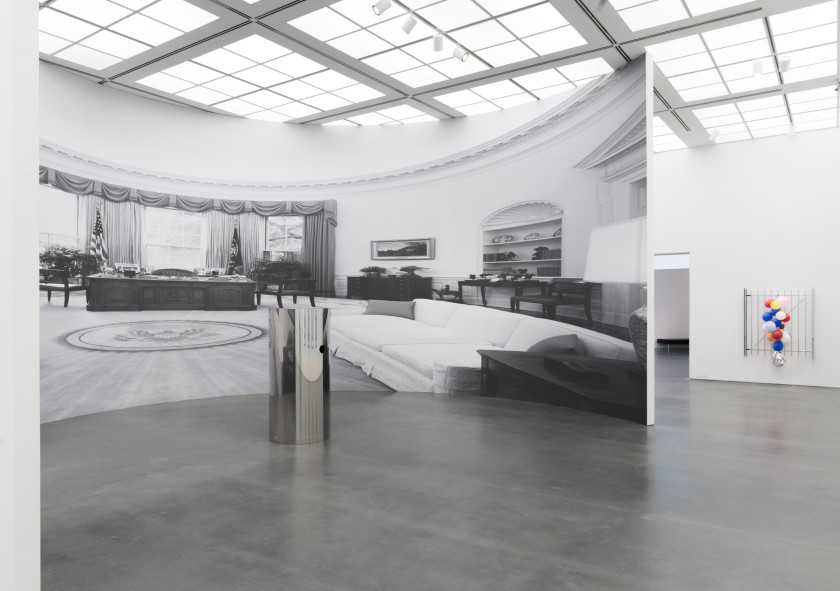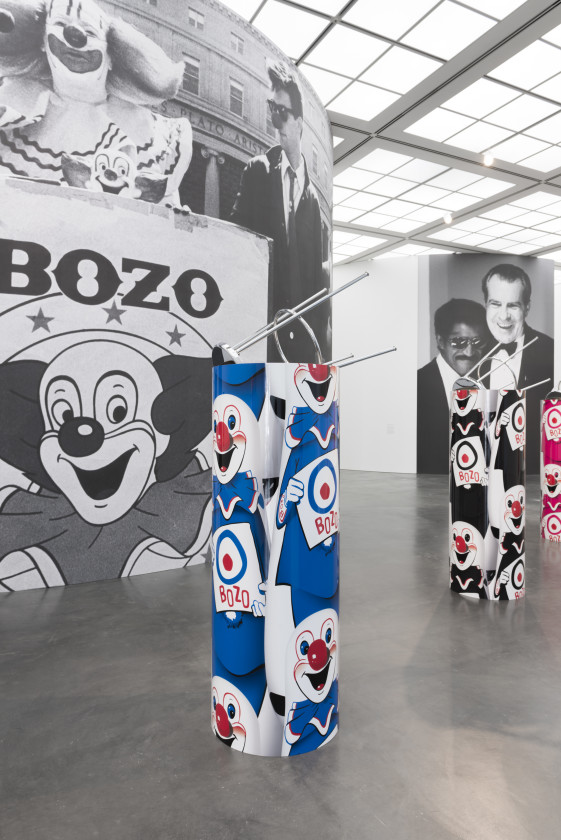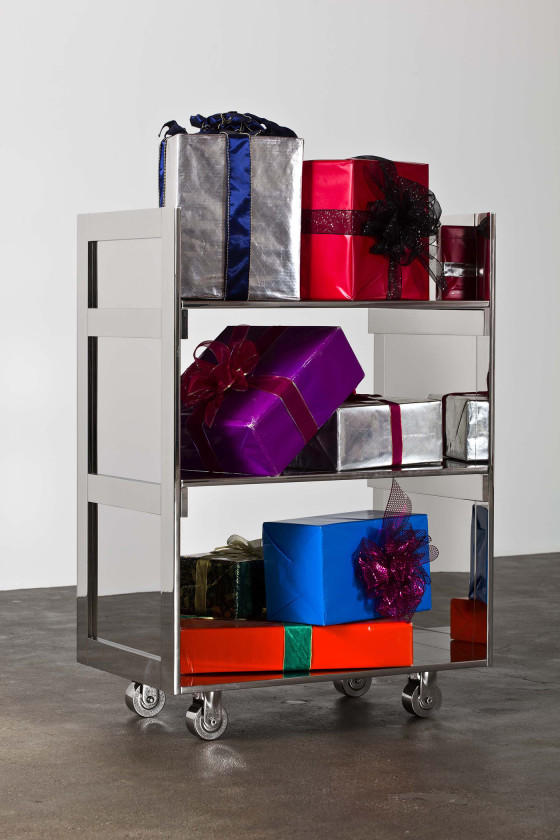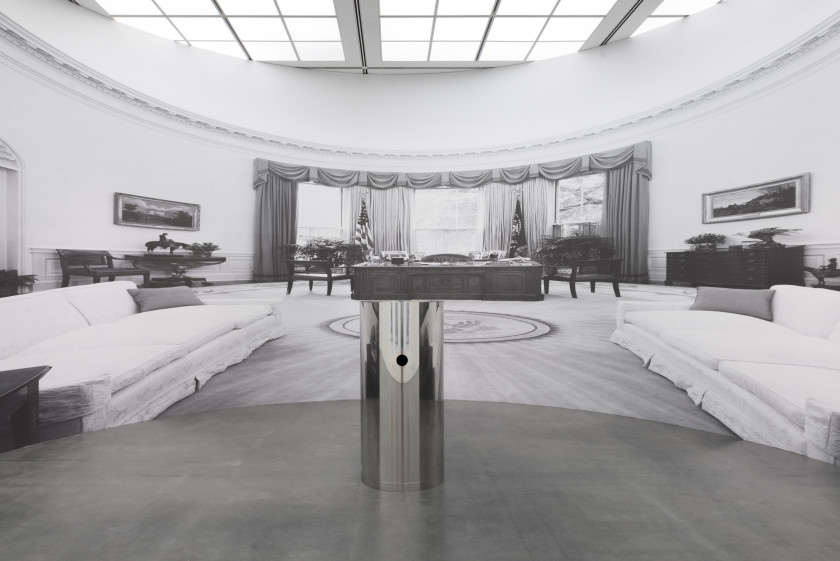Kathryn Andrews: Menace in the Details // MCA Chicago
by Natalie Hegert

The western sky burned orange like a hot ember, searing the sharp silhouettes of palm trees onto my retinas as I guided my car over the onramp of the 5 freeway, headed north to Highland Park. Speeding up to slow down, red brake lights sparked on and off ahead as I advanced through the usual evening traffic. Next to me, an off-duty ice cream truck wanly reflected the fading vermilion sky off its polished chrome sides.
Los-Angeles-based Kathryn Andrews’ studio sits at the end of a non-descript, blocky building, near a freeway interchange, on the north side of the city. On the corner sit two competing burger joints across the street from each other—one, a gleaming international chain, the other, the kind of shabby, homegrown hamburger stand that is ubiquitous in these parts.

Greeting me at the door of the studio is Andrews, smiling broadly, and a row of assistants on computers, drafting up 3-D models. There aren’t many finished works in the studio at the time, just worktables and large sheets of paper with specs for new works in progress. On one wall, a life-size, black-and-white photograph of a model gazes out alluringly from behind Plexiglas, framed in chrome, as though trapped in a commercial doorframe. Andrews put together a makeshift table out of two wooden sawhorses and a piece of plywood for us to sit at—we talked about her work in Run For President, her most recent solo exhibition that was on view at the Museum of Contemporary Art (MCA) Chicago.
In the exhibition, Andrews—whose work concerns the production of image culture, disrupting our seamless consumption of signifiers—took as her subject a presidential race. Here, the art comes right up to shake your hand. It is big, bold, and impressive, with overwhelming photomurals of Bozo the Clown, Richard Nixon and Sammy Davis Jr., Nancy Reagan and Mr. T, and a panoramic view of the Oval Office. There are shiny sculptures of chromed aluminum, spotless in their perfection. Brightly colored paintings, balloons, presents, and even a red carpet are part of the installation—it is a celebration, a massive political party, and you are the primary constituent, gazing at your own reflection in the polished silver.

But as with any campaign promise, closer inspection will reveal the caveats. Embedded within the works is an element of discord between the image and reality; between manufactured authenticity and hidden complexities. Things are not always what they seem, and there might be menace in the details: look closer and you see a gun concealed in the shiny cylindrical sculpture on view. Look closer and you see evidence of wear and tear on the corners of the gift boxes—rented Hollywood props, meant to be used again and again. Despite their carefree smiles, there is a thorny back-story behind the monumentally scaled photographs. Andrews’ art lies in that friction, where pristine images rub against the shabby corners of lived experience.
NATALIE HEGERT: Did you have any idea what a huge farce the election would become when you started conceiving this exhibition?
KATHRYN ANDREWS: No. [laughs]
NH: [laughing] It is like every day your exhibition becomes more pertinent in this scary way.
KA: Or more irrelevant. When I conceived of it, it seemed funny to cite odd characters and individuals who have had an unlikely relationship to the presidency. In light of the impending election, with its over-the-top candidates, any citation of the humorous or unusual seems almost meaningless now. Humor fades in the face of extremism.
NH: Especially when faced with the prospect of a preposterous candidate actually holding power. Like a clown holding a gun—it is suddenly not very funny anymore. How do you see these figures operating in the exhibition now? In Run For President, we have Bozo the Clown, Mr. T, Nancy Reagan, Richard Nixon, and Sammy Davis Jr. It seems there are a lot of different ways to interpret these particular images.
KA: One part of the exhibition explores how an American worship of celebrity has enabled individuals to move into positions of power that could not do so otherwise. For example, Sammy Davis Jr. is depicted in a giant wall mural, arm in arm with Richard Nixon. In the 1930s, at the age of seven, Davis starred in a short movie, Rufus Jones for President, which portrayed a black child being elected into office. The film was highly racist—made by white Hollywood producers for black audiences. Forty years later, because of his popularity as an entertainer, Davis was invited to be the first African American presidential guest to spend the night in the White House. Of course we know it took another 35 years before we actually elected a black president. The exhibition considers the tragedy of some of these inequalities and their relationship to image culture.

NH: I saw that Mr. T just visited the exhibition.
KA: Yes, twice! Isn’t that amazing? He heard he was depicted in it so he stopped by to check it out. And he handed out some Mr. T paraphernalia while he was there.
NH: An impromptu performance! The three Bozo cylinders at the front of the exhibition are also made available for performances by comedians. When did you start thinking of using sculptures as stages for performance?
KA: I am interested in the idea that when we put artworks into different situations, they take on different meanings. I liked the idea that a sculpture can seem to be about one thing, yet when you combine it with something else—another work or say a performance—it reads differently. In the case of the Bozo sculptures, they will be used in collaboration with the Chicago-based stand-up comedian Felonius Munk. I liked the idea of bringing actual stand-up into the context of the exhibition, further looking at an interplay of entertainment and politics.
NH: To what extent does the viewer’s perception shape the direction your work takes? I am recalling a few points here from your conversation with Hamza Walker, which appears in the catalogue, where you are talking about how the audience will generalize ideas about what an artist does, or what art does, and how you like to work within those assumptions, or subvert those tendencies.
KA: It is hard to pinpoint how viewers see things, but I am definitely interested in how what might be called “collective perception” results in the eradication of the perception of difference or nuance. I do think about how viewers make sense of new things based on what they already know. I try to overturn or subvert those go-to associations.
NH: Can you expand on this idea of “collective perception?” How do you go about overturning or subverting these associations?
KA: I spend a lot of time researching popular imagery, exploring its symbolic, historic, and contemporary associations. I am frequently trying to create situations [in my work] where such imagery can be used in new ways.
NH: Many of the readymades that you use in your sculptures in the show—campaign buttons, props, and costumes from certain films—come packaged with their own embedded associations. They are “loaded objects,” not to mention the quite literal appearance of a gun, which is pointed at the viewer in the sculpture Lethal Weapon (2015). What is your process like in terms of positioning and placing these objects in dialogue with one another, and with the other elements of your sculpture? My favorite is definitely Coming to America (Filet o’ Fish) (2013), which not only has this really interesting interplay between various signifiers of commercialism, comedy, and race, but also scale.
KA: The combinations often come from a lot of play and brainstorming. I am frequently looking at what kind of sense or nonsense is produced when any two things are put together. What at first appears to be nonsensical can often have a lot of truth about it.
NH: How does that process work, and why do you choose to work with film props?
KA: I have frequently worked with props, divorcing them from their filmic context and inserting them into an artistic one. I like that because the object is stripped of its original purpose, yet it still carries its history, so you get both. In Coming to America (Filet o’ Fish), I used fake coins produced specifically for the film depicting Eddie Murphy as the Prince of Zamunda. I have been collecting Hollywood currency for some years and had those coins sitting around. When I saw the McDonalds’ pirate head, another component in that sculpture, I wondered about pairing it with the film coins. The more I thought about it, they seemed to go together perfectly. The movie makes a lot of jokes riffing on McDonald’s and American fast food culture. And the pirate character makes a lot of sense with coins. Pirates chase loot. When these elements are combined, the piece starts to talk about serious political issues, and they are specific to America. While this approach seems incredibly silly on one level, it is actually dealing with some very deep issues about individual agency and equality.